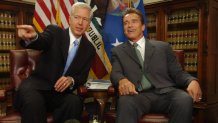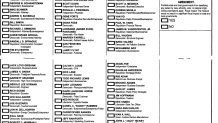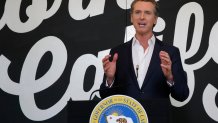What to Know
- An effort to recall California Gov. Gavin Newsom began June 10, 2020. Petition supporters had until March 17 to collect 1,495,709 valid signatures.
- The current petition effort is the fifth in a series of six recall petitions filed against Gov. Newsom. The others are currently inactive.
- There have been 55 attempts to recall a California governor since 1911. One was successful and ended with voters sending Arnold Schwarzenegger to Sacramento.
In 2018, Gavin Newsom, then the lieutenant governor of California, was elected in a landslide as governor of the nation’s most populous state with nearly 62 percent of the vote. Two years and a few months later, voters are about to be asked whether he should be ousted from office after one of six recall petition efforts against him gained enough signatures to qualify for the election.
The date of the recall election has been set for Sept. 14.
The recall process in California is a slow-moving one with many steps along a procedural path that ends with to two key questions for voters in a simultaneous recall election: Should the governor be recalled? If so, who should replace him?
Get top local stories in Southern California delivered to you every morning. Sign up for NBC LA's News Headlines newsletter.
Below, a look at the rules of recall elections in California.
What’s a recall?
“Recall is the power of the electors to remove an elective officer.”
Local
Get Los Angeles's latest local news on crime, entertainment, weather, schools, COVID, cost of living and more. Here's your go-to source for today's LA news.
That’s the one-line definition of a recall in Article 2, Section 13 of the California Constitution. The nation’s most populous state and 19 others have laws that outline a process by which voters can recall an elected official from office.
When is the recall election?
The date of the recall election has been set for Sept. 14, Lt. Gov. Eleni Kounalakis announced. It's a tight timetable that gives candidates just a few months to get their messages out.
How common are gubernatorial recalls in California?
Very. There have been 55 attempts, including six targeting Newsom, to recall a California governor since 1911. One was successful. That was in 2003, when Democratic Gov. Gray Davis was recalled by voters, who then replaced him with Republican Arnold Schwarzenegger. Davis' recall was the second in U.S. history, coming more than 80 years after North Dakotans recalled Gov. Lynn J. Frazier. Since then, only one recall effort -- a failed 2012 attempt to oust Wisconsin Gov. Scott Walker -- has gained enough momentum to go before voters.

How does the process get started in California?
First, petition organizers must declare their grievances with the current office holder. The process outlined in the California Constitution starts with a petition listing reasons for the recall, which is sent to the California Secretary of State. The current petition effort is the fifth in a series of six recall petitions filed against Newsom. The others are currently inactive.
How many people need to sign the petition?
In California, 12 percent of registered voters in the last election for the governor's office from at least five counties are required to get the effort off the ground. That means supporters of the Newsom recall effort needed 1.495,709 valid signatures. The number is actually higher because of the likelihood of duplicate or invalidated signatures that are thrown out. California's 12 percent threshold is among the lowest in the country when it comes to gubernatorial recalls.
How many signatures are on this recall petition?
The goal was to reach 2 million in the state of 40 million residents. At the filing deadline on March 17, organizers said they believe they have collected nearly 2.1 million signatures. The California secretary of state’s office announced April 26 that more than 1.6 million signatures had been verified, about 100,000 more than needed to force a vote.
What’s the timeline for collecting signatures?
Once the reasons for the recall are delivered to the Secretary of State, proponents usually have 160 days to gather signatures. Newsom recall supporters were given four additional months because of the pandemic. The Newsom recall effort began June 10, 2020, which gave supporters until March 17 to collect 1.495,709 valid signatures. The signatures can be submitted at any time within that window.
What happens after the signatures are gathered?
The multi-layered certification process requires several steps involving different elections officials in addition to county-level preparations needed to conduct a statewide election. So, that's why it took some time to arrive at the Sept. 14 election date.
People who signed petitions have 30 days to withdraw their signatures, though it’s unlikely enough will do so to stop the question from going to voters.
Here's a closer look at the many checkpoints in the petition signature review process.
What would be on a recall election ballot?
Some states hold separate recall and candidate elections. Virginia's unusual recall process involves a trial before a circuit court. Simultaneous recall election models, like the one used by California, get everything over with at once. The ballot would include two questions for voters.
1. Should Gov. Gavin Newsom be recalled?
2. Who should succeed him if he is recalled?
The first question requires a majority vote to approve a recall. Determining the outcome of the second question is less complicated — the candidate with the most votes wins.
How many candidates would be on the ballot?
In 2003, 135 candidates entered the race. The image below is what the crowded ballot looked like in October 2003.

The recall was approved, and Schwarzenegger ended up with nearly 49 percent of the vote to become Davis’ replacement.
The most prominent Republicans running to replace Newsom are former San Diego Mayor Kevin Faulconer and reality TV star Caitlyn Jenner, who has never run for elected office. Businessman John Cox, who lost badly to Newsom in 2018, and former Congressman Doug Ose, also are running.
In all, there are more than 40 names on the ballot, including conservative talk show host Larry Elder, who has emerged as a front-runner among challengers.
One more thing: There's nothing to stop another Democrat from entering the race. In 2003, then-Lt. Gov. Cruz Bustamante was on a crowded ballot.
Why has Newsom become a recall target?
Let’s start with the recall petition. Here are the reasons outlined in its text.
“The grounds for this recall are as Follows: Governor Newsom has implemented laws which are detrimental to the citizens of this state and our way of life. Laws he endorsed favor foreign nationals, in our country illegally, over that of our own citizens. People in this state suffer the highest taxes in the nation, the highest homelessness rates, and the lowest quality of life as a result. He has imposed sanctuary state status and fails to enforce immigration laws. He unilaterally over-ruled the will of the people regarding the death penalty. He seeks to impose additional burdens on our state by the following; removing the protections of Proposition 13, rationing our water use, increasing taxes and restricting parental rights. Having no other recourse, we the people have come together to take this action, remedy these misdeeds and prevent further injustices."
The petition text only tells part of the story. For example, it says nothing about Newsom’s handling of the coronavirus pandemic, which recall supporters have criticized. He faced widespread public backlash for dining out with friends and lobbyists at San Francisco Bay Area restaurant French Laundry last fall, while telling residents to stay home. State audits also revealed missteps that contributed to at least $10 billion in unemployment fraud.

What’s Newsom say about all this?
Until a March 2021 interview with a San Francisco TV station, Newsom hadn't said much about the recall, insisting that he is focused on the pandemic, vaccinations and other issues facing California. Newsom made his most direct comments yet about the push to unseat him during an interview March 12 chat with KQED, saying his opponents are taking aim at his his broader progressive policy agenda.
“It’s about immigration. It’s about our health care policies. It’s about our criminal justice reform. It’s about the diversity of the state. It’s about our clean air, clean water programs, meeting our environmental strategies,” he said.
On March 15, Newsom established a political committee to begin raising money to defend his seat in a potential recall election, the strongest acknowledgment to date that he expects to be on the ballot this year.
In December, Dan Newman, a spokesman for the governor, called the recall effort a costly "distraction and circus."
"This is a ragtag crew of pro-Trump, anti-vaccine extremists, along with some ambitious Republican politicians who would like to be governor," Newman said. "I don't think it's something anyone wants. I'd be surprised if Californians wanted to spend the extra money and have another election the following year."
During his March 9 state of the state address at Dodger Stadium, Newsom did not specifically mention the effort to recall him from office, but he delivered a bright assessment of where California is heading.
"The state of our state, it remains determined,'' he said. "I remain determined. And I just want you to know, we're not going to change course just because of a few nay-sayers and dooms-dayers. So to the California critics out there who are promoting partisan, political power grabs without outdated prejudices and rejecting everything that makes California truly great, we say this: We will not be distracted from getting shots in arms and getting our economy booming again. This is a fight for California's future.''
Who organized the petition?
A Folsom resident by the name of Orrin Heatlie filed the current Newsom recall petition and one other, which failed to make the ballot in November 2020. Other board members listed on the Recall Gavin Newsom site include Mike Netter, who served as an exec with Corporate Express and Staples, and Robin McCrea, a budget officer/analyst at CSU Chico.
Who’s funding the effort?
In February, the California Republican Party announced it is giving $125,000 to the campaign. Days earlier, the Republican National Committee gave the state GOP $250,000 intended to aid the recall drive. The campaign also received money from wealthy individual donors.
If the governor is recalled, how long would the election winner stay in office?
A replacement for a recalled governor serves out the remainder of the governor's term. Newsom's current term, his first, ends in January 2023 after the governor's office is contested in the November 2022 election.
When would the new governor take office?
County elections officials have 30 days after the election to complete the official canvass. On the 38th day after the election, if the recall is successful, the Secretary of State will certify the election results
The new governor would then take the oath of office remain there for the rest of the term.



